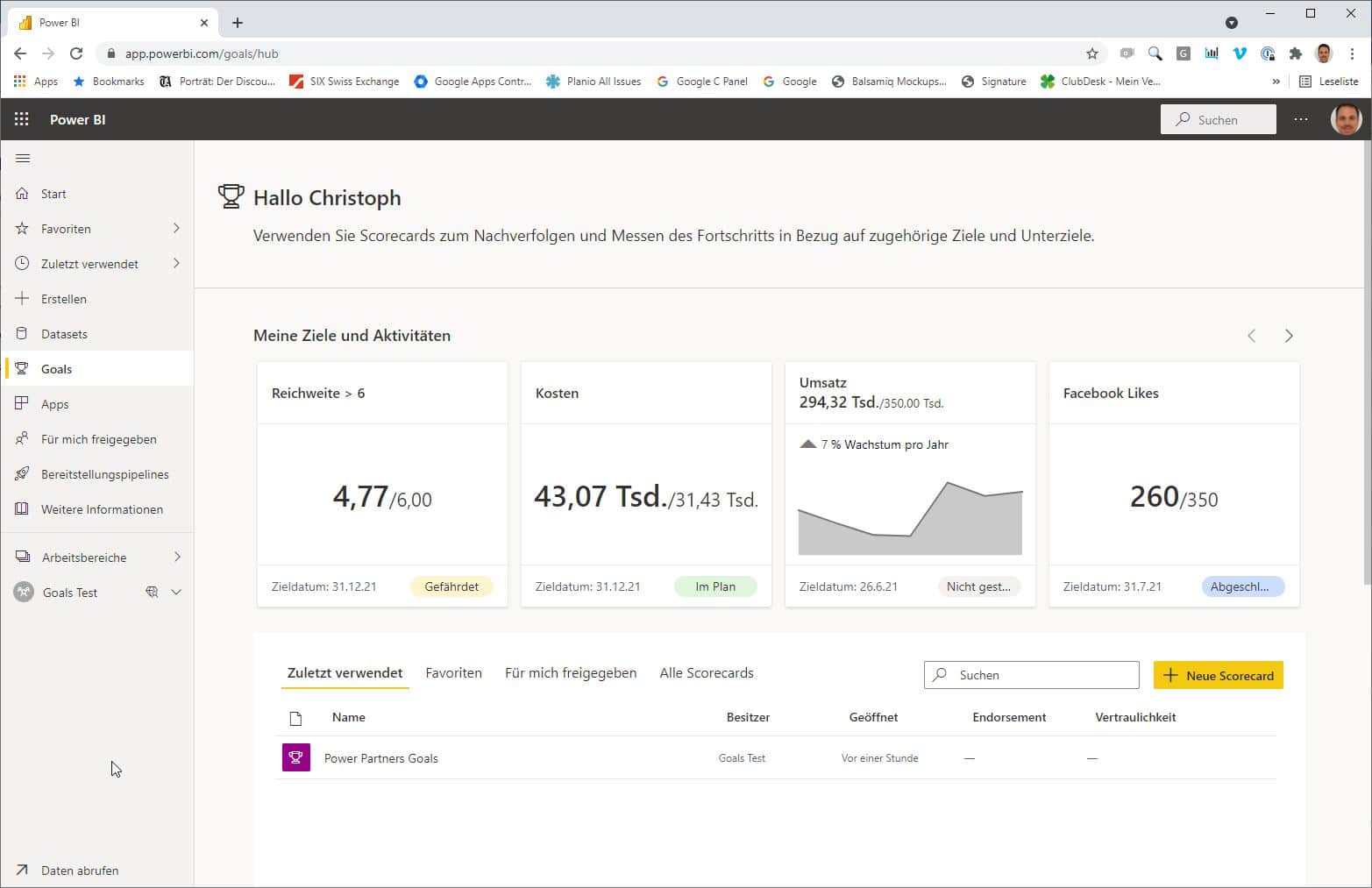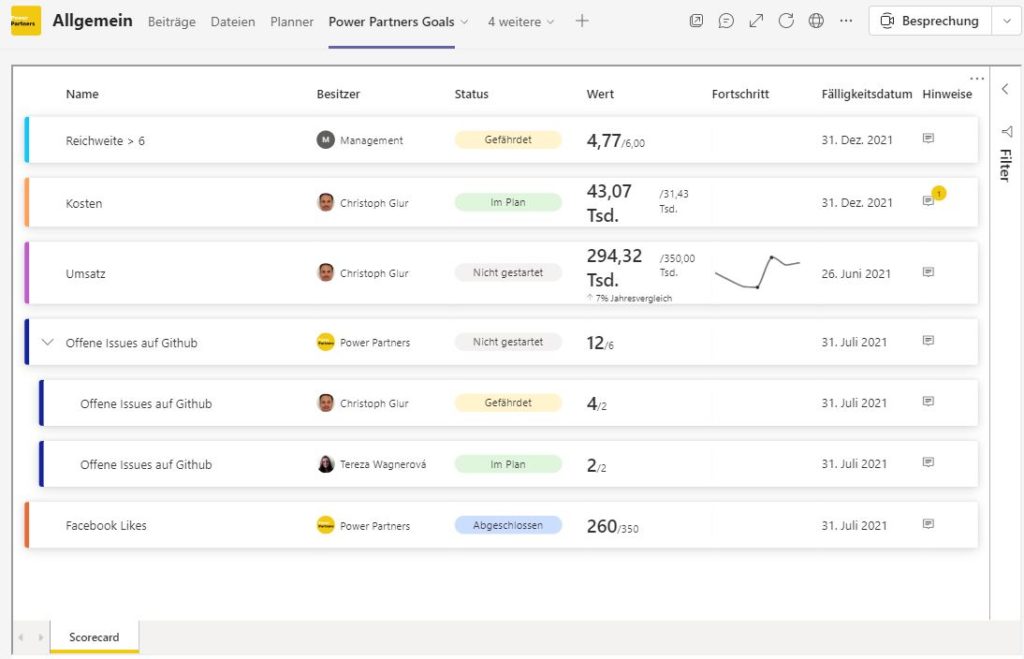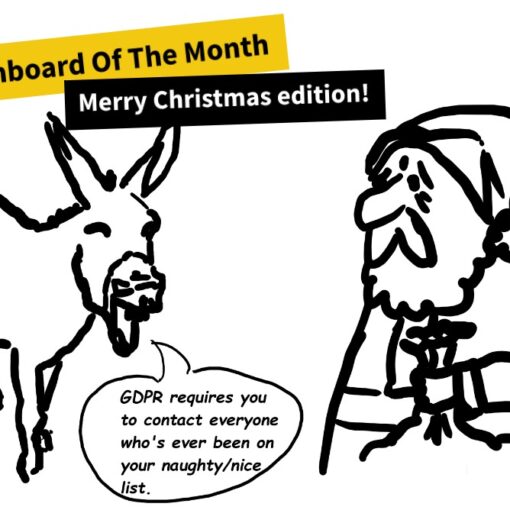The latest feature of Power BI is called "Goals". With Power BI Goals you define and structure your goals. Or the goals of your company. Or your team. The highlight? With one click, you connect a target to a Power BI report. This is how you ensure that Power BI automatically updates the status of your target in the background. At Power Partners, we are excited about this new functionality. No wonder, then, that the use of Power BI Goals is a done deal. In this post, you're learning what Power BI Goals is and what you can use it for. So let's go! Set the direction and transform your crew into a sworn team that pulls in the same direction.
Power BI Goals: Introduction
Highlights
Direct entry for the hurried reader. This is what Power BI Goals has to offer:
- Goals can be defined and displayed in a scorecard. Any number of scorecards can be defined, for example per team, per department, or per OKR period.
- Each scorecard can contain any number of goals.
- A scorecard is part of a Power BI workspace. Thus, access to scorecard scan be set as desired, for example per team or for individual employees.
- It is possible to define hierarchical goals.
- A target can be assigned to one or more people, or a group.
- Targets can be connected to Power BI Reports. In the background, Power BI then retrieves the data and always displays the current status.
- It is also possible to define manual and qualitative goals and enter the status manually.
- Power BI Goals is seamlessly integrated with Microsoft Teams. So the goals are not just in your head or in a dusty Excel.
Get a first impression of goals in Power BI
In the Power BI service, Goals has received its own main menu point. This shows that Goals are an important innovation for Microsoft.

And this is what a scorecard looks like when integrated into teams:

And in the following short video you can see the whole thing in action:
Prerequisite
Public Preview
Power BI Goals was presented by Microsoft in May 2021. As of now (June 2021) it is in the Public Preview. What does that mean? Public Preview means that Power BI Goals can be used productively by all customers. However, not all planned features are available yet, and changes to the module are still possible.
Who can use Power BI Goals?
To use Power BI Goals, you need a Microsoft Tenant, i.e. a Microsoft 365 enterprise account. If you already use Microsoft 365 in your company, basically everything is there, and you only need the right license (see next point).
If you don't use Microsoft 365 in your company and don't have a Microsoft Tenenant, then you can register at https://app.powerbi.com. However, this is only possible with a company email address. Gmail, Hotmail or GMX, etc. do not work.
If your company is not yet using Power BI, it may make sense to first inform yourself about costs and strategy or get advice. If you like, you are welcome to benefit from our non-binding and free online consultation for this purpose. You can make an appointment in just three clicks via the following link:
Which license do I need?
To use Power BI Goals, you need Power BI Premium or the new Power BI Premium per User (PPU) license, which is currently available for € 16.90. This is about twice as expensive as the Power BI Pro license. To be fair, however, it has to be said that Power BI PPU offers other great features in addition to Goals, such as e.g.
- extended data flows
- much more storage space
- 48 refreshes per day (instead of 8)
- Paginated reports (i.e. printable reports with page breaks, as known from Reporting Services (SSRS)
- Pipelines
- and more
Please feel free to contact us via our form to receive our free info package regarding licenses and Power BI costs.
Roadmap of Power BI Goals
Goals is in Public Preview. Thus, the feature is only visible if the preview has not been blocked by your administrator. So if you meet all other requirements (e.g. a Power BI Premium license) and do not see a Goals Menu, then talk to your internal IT administrator or your system house.
Public Preview automatically means that it is a young solution. It cannot yet provide the stability and robustness of the long-standing platform. Despite everything, the solution looks mature and suitable for productive use.
The following extensions and improvements are planned for the future:
- Support for smartphones
- Automatic and rule-based update of status, for example when reaching a goal
- Rollups (aka aggregations) of subtargets to overall targets
- Personalize the display of goals
- Power Automate Integration
- Cascading goals to roll out uniform goals to departments, locations, or groups of companies. This is particularly interesting for large companies.
Not yet subscribed?
Have you already subscribed to our monthly newsletter, Dashboard of the Month? Month after month, we present a dashboard and share insight on how our customers design smart KPIs, how they set their goals, and how they make sure they reach them by tracking progress in a Power BI dashboard. Not to miss!
Use Cases for Power BI Goals
Why is Microsoft doing such a big thing around goals? In our view, this has to do with two factors.
On the one hand, management practice has changed a lot in recent years. Agile methods are on everyone's lips and influence not only start-ups, but also medium-sized companies and corporations.
In addition, there is a trend in the field of BI (Business Intelligence): Data Self-Service (aka Self-Service-BI, SSBI, or Self-Service Analytics). See here for an introduction.
It is therefore assumed that companies are moving away from heavy hierarchical, central CPMs (see below) towards lightweight, self-organizing target tracking tools. And this trend does not stop at Microsoft.
And that's exactly why we believe that Goals is not only interesting for corporations. On the contrary: Goals is also ideal for entrepreneur-led companies and hidden champions.
But how exactly can you now use Power BI to better manage your business? In practice, there are a variety of management and leadership methods based on systematic objectives. A final listing would lead too far, but we do not shy away from a short introduction with further links. So, here comes you, our list of Power BI Goals use cases:
Objectives and Key Resources (OKR)
Objectives and Key Results is a method for defining and tracking goals within a company. It is used, among others, by Google ... and applied by Power Partners. For newcomers, impulse magazine offers a short introduction to the OKR method.
The fascinating thing about OKR is that the method is suitable for both small and large companies.
Goals in Power BI are very generic, can be mapped and hierarchically structured. Thus, the feature offers all the prerequisites to be used as an OKR board.
Open Book Management (OBM)
Open Book Management is a management method that enables employees to make independent decisions that move the company forward through transparency. This is achieved through training (e.B. in the field of finance), gamification and scoreboarding (i.e. access to information). If you are interested in this topic, the eye-opening book Rules of the Game For Game Changers by Kerstin Friedrich is recommended.
In her book and in her consulting, Kerstin Friedrich mainly relies on physical, creative scoreboards. And although we at Power Partners are a digital company deep in our DNA, we are enthusiastic about crafted score boards that appeal to all the senses and increase the commitment of the workforce. We keep it that way with us that we occasionally build a Pyhsian scoreboard for strategic goals. However, we map the regular OKR process digitally, which is also compatible with home office.
Management by Objectives (MbO)
MbO is the classic management approach that controls employees through target agreements. A short introduction can be found in this article by HR Today. Even if the effect is often questioned, the approach is very widespread in various variations and forms.
We believe that MbO can only work if the method is firmly anchored in the company and the goals can be explicitly tracked and tracked.
Whether Power BI Goals is suitable for this, we can not yet conclusively assess due to lack of experience. If you implement Management by Objectives in your company, we would be very pleased to have a comment in the form field below.
Benchmarking
Benchmarking is about comparing yourself to the best in the same sector. This is achieved by defining an index for different metrics (e.B. growth, fixed costs, marketing budget, return on sales, etc.), and then comparing the performance of your own company with this index. Industry associations often also offer such benchmarks or comparative indices. An introduction to benchmarking can be found at business-wissen.de.
As with Power Partners, big fans of benchmarking are. In our opinion, far too little is placed on benchmarks, especially for small and medium-sized enterprises. One reason for this is that it is often too time-consuming for companies to calculate their own measured value. And this is exactly where Power BI comes into play: With Power BI, you can automate the calculation of your key figures.
Of course, Power BI Goals is also suitable in the area of benchmarking. Because you can not only automate the current measured value, but also the benchmark in the target. For example, you can simply define the following goal: "I want to have a higher sales margin than my competitors". The target margin is not fixed, but updates dynamically, e.B. on the basis of the industry index.
Key figures (KPI)
The business world is full of key figures. We go so far as to claim that there is no entrepreneur who does not track at least one metric - even if it is only profit. In addition to the well-known key figures from financial controlling, there are key figures from all areas, e.B. (small selection)
- Finance: Sales margin
- Production: total downtime of the equipment
- Sale: percentage of offers accepted
- Human Resources: Average seniority
- Web Analysis: Net Promoter Score
- Project management: Scheduled hours vs. actual hours
At Power Partners, we eat key figures for breakfast. It's our turn to build a KPI library that now contains well over a hundred KPIs. Who knows, maybe in the future we will publish an e-book with a collection of common key figures? Please report if this might be of interest to you.
But back to the main question: Is Power BI Goals suitable for tracking KPIs? yes! We even believe that this is the main use case.
Corporate Performance Management (CPM)
There is a class of software applications called CPM (Corporate Performance Management), or sometimes Business Performance Management (BPM) or Enterprise Performance Management (EPM). Controllers of larger companies are nodding now for sure. All others: Here's more info. And all together, of course, the question burns on the tongue: Is Power BI Goals a CPM? Can I use Power BI Goals to replace my existing CPM.
Our opinion is that Power BI Goals should not be seen directly in competition with a classic CPM system. CPM systems are monster toys for corporations. They are designed to collect and aggregate measured values from different departments and to compare them with the goals of the Executive Board for senior management. Of course, you can also do all this with Power BI Goals. But it is not designed for the management of a large number of goals. Rather, it seems to us that the Power BI Workspace structure and integration with Microsoft Teams is more aimed at smaller teams with agile working methods.
Furthermore, classic CPMs are often more oriented towards financial goals, for example for tracking companies within a group, or for controlling cost centers. Power BI Goals can be used much more generally and is therefore - as described above - ideal for managing and visualizing various types of goals, not only from the financial and classic controlling area.
Balanced Scorecard (BSC)
Balanced scorecard is a method that is mainly used in large companies and corporations. At its core, the management method divides the management focus to different perspectives, with each perspective covering a different stakeholder (finance, customers, processes, employees, etc.). For the perspectives, KPIs (Key Performance Indicators) are then defined, which can be tracked by the management and the division heads.
Traditionally, companies that use BSC use CPM software or a specialized BSC tool. Whether it is suitable for Power BI as a replacement for a specialized CPM remains to be seen - similar to MbO (Management by Objectives).
Feedback welcome!
All this is only our personal assessment. And if you use Power BI Goals as a classic CPM, then be sure to contact christoph.glur@powerpartners.pro or write a comment directly at the bottom of the post. We are very interested in different use cases and first experiences!
Conclusion
We think Power BI Goals is a successful extension of Power BI. The handling is simple and the integration is seamless. And yet the scorecards bring a clear added value compared to classic dashboards. Creating a target board is almost self-explanatory. By integrating with the data sets in Power BI, the module enables a clear step towards self-service BI. So you don't need to take a course in data science to use Power BI Goals.
Whether the costs for a Power BI Premium license are worthwhile, you must of course decide for yourself. All in all, however, the price seems to us more than justified compared to other solutions, especially since the seamless integration with Microsoft 360 and Microsoft Teams creates added value that can not be offered by any isolated solution.
And as a little tip: If you have been wondering for a long time how you can establish a data culture in your company, then you may have found the answer with Power BI Goals. After all, who wants to be in a bad position when their progress is measured on a daily basis?
On the other hand, it must also be mentioned that with certain advanced use cases, you notice that Power BI Goals is still a young solution. And a look at the roadmap also shows that a whole series of features are planned for the future that we can look forward to!



